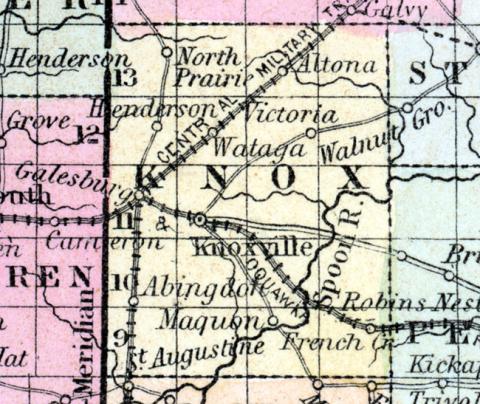GALESBURG This flourishing city is situated in the north-east part of Knox county, 5 miles from Knoxville, the county seat, and 168 miles west-south-west from Chicago, at the junction of the Chicago and Burlington, Northern Cross, and Peoria and Oquawka railroads, giving it direct communication with the Mississippi and Illinois rivers, and the great central market of the west, Chicago. Charters have already been granted for two other railroads, viz.: The Galesburg and Muscatine, and the Rock Island and St. Louis, both of which will, when completed, connect at this point with those already in operation. The city is built on what was once "bounty laud," being an elevated prairie, whose fine streams flow into the Illinois river on the east, and the Mississippi river on the west. On the north is Henderson's Grove, and on the west, Cedar creek timber belt, both of which add greatly to the otherwise beautiful appearance of the city. The inhabitants are, to a great extent capitalists from the east, who have been attracted here by the beauty of the location, the salubrity of the climate, and the superior facilities presented for carrying on their various business enterprises with profit It was settled in 1837, but did not obtain a charter as a city until 20 years later (1857). Its advancement during the first 15 years after its settlement was slow and steady, but in December, 1854, the first train of cars entered its borders, and gave new life and energy to everything around. In educational advantages, Galesburg ranks among the first of our western cities outside of Chicago, there being two colleges and a university, viz.: Knox College, Knox College for females, and Lombard University. The first of these was chartered in 1837, and formed the nucleus around which have centered others of a similar character. It has an endowment of $25,000, and has at the present time near 600 students, under the presidential management of Rev. J. Blanchard, D.D., aided by 11 professors and tutors. Lombard University (Universalist) is of more recent date, and is divided into male and female departments, under the presidency of Rev. O. A. Skinner, for many years a clergyman in Boston, Massachusetts. The female department is under the charge of Miss H. A. Kendall. The university is named in honor of Benjamin Lombard, Esq., the principal patron, who generously contributed $20,000 toward its erection. Donations of money and land, to the amount of nearly $80,000, have also been received from other friends of the institution. It is supported by the sale of scholarships, $70,000 of which have already been disposed of. Besides these higher institutions of learning, there are a number of private and public schools, where the various English branches are taught. The principal hotels are the Henshaw, Galesburg, Bonny, Kellogg and Tremont Houses, and City Hotel. All these are considered first class.
The city has two newspaper offices, two steam flouring mills, a steam sash and door factory, a steam saw and planing mill, and an agricultural implement factory, also operated by steam; a large foundry, machine shop, furniture manufactory, etc.
There is one chartered bank, besides several private banking institutions, an insurance company, and several agencies for foreign companies. The mercantile business of the city is large, several firms doing to the amount of from $70,000 to $100,000 annually. The colleges, hotels, and other public buildings are of brick, built after the most approved modern styles, and are objects of interest which readily present themselves to the eye of the stranger. The streets are laid out at right angles, are wide and commodious, and kept in good repair.
The health of the city is noted, surpassing that of almost any other city of the same size in the west. Population, about 7,000. G. C. Lamphere, Postmaster. (Hawes' Illinois State Gazetteer...,1859)
Annotations
Total Population 1850
323
Total Population 1860
4953
Latitude
40.950217
Longitude
-90.376564
Type
City or Town
County
Knox
State
Illinois

